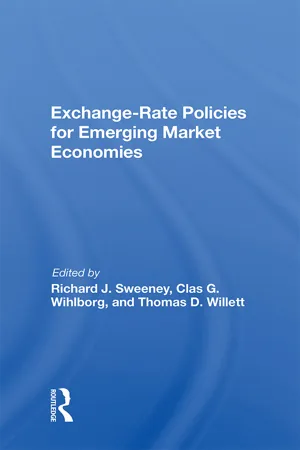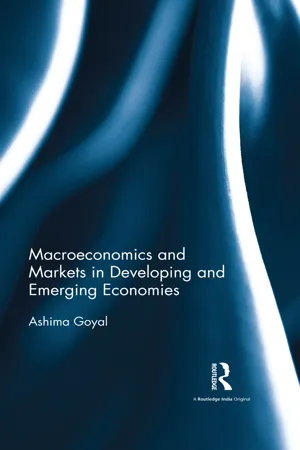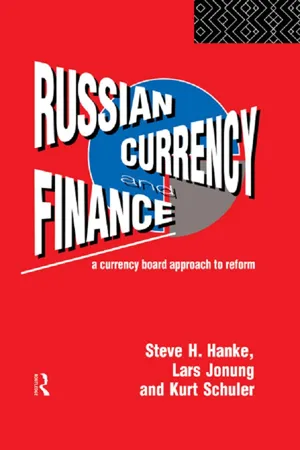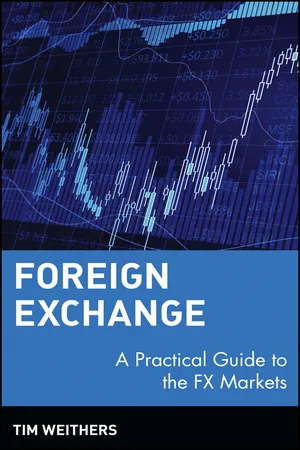Currency Board
A currency board is a monetary system that maintains a fixed exchange rate with a foreign currency by holding reserves in that currency. It issues domestic currency fully backed by foreign reserves, ensuring stability and credibility in the monetary system. This system limits the ability of the central bank to conduct independent monetary policy, as it must maintain the fixed exchange rate.
8 Key excerpts on "Currency Board"
- Richard J Sweeney(Author)
- 2019(Publication Date)
- Routledge(Publisher)
...Historically, the record is not encouraging: until the 1980s and 1990s, no Currency Board has lasted very long nor has any of their pegged rates. Indeed, some say that "permanently fixed exchange rates" is an oxymoron. The fact that the country maintaining the peg must often take action to protect the peg's value means that there may come a day when the game appears not worth the candle, and the "permanent" peg is changed. A Currency Board is one among many mechanisms for running a fixed exchange rate. The most fervent Currency Board advocates recognize that there are either formal, de jure escape hatchs that allow changes, or informal, de facto ways that allow changes (peg changes are historically accompanied or preceded by changes from a Currency Board to some other form of exchange rate management, usually a central bank). Most Currency Board advocates view the establishment of a nominal anchor as the board's main contribution. The rules that govern a Currency Board impose monetary and, perhaps to a lesser, indirect extent, fiscal discipline, and keep the country from inflating as much as it otherwise would. To the extent the Currency Board succeeds, it spares the country the costs of high and erratic inflation. 1 Further, establishing a (strong) Currency Board may help lend credibility to the government's commitment to fight inflation; a credible commitment to an anti-inflation policy reduces inflation more quickly, and at lower cost, than a commitment that proves itself only gradually and incurs the cost of output losses and excess unemployment. In addition, many Currency Board advocates envision the board as operating in the context of free-market international trade and no or relatively minor capital controls. By contributing to financial and monetary stability, the board helps the economy reap the benefits of international openness, benefits less available to countries with substantially less discipline...
- Ashima Goyal(Author)
- 2016(Publication Date)
- Routledge India(Publisher)
...Currency Board Strict fixed exchange rate system, with institutional (legal and even constitutional) constraints on monetary policy and no scope for altering the parity. The monetary authority only can issue domestic money when it is fully backed by inflows of FX. The system maximises credibility and reduces problems of ‘time inconsistency’. The system increases credibility but reduces flexibility. Large external shocks cannot be accommodated through exchange rate changes, but have to be fully absorbed by changes in domestic unemployment, prices and economic activity. The central bank loses its role as lender of last resort. Small countries have had systems of this type, but have often been forced to abandon the regime when faced with major external shocks. In 2010, Hong Kong and Estonia had Currency Boards. Bulgaria had quasi-Currency Boards’ arrangements. Argentina abandoned its Currency Board in January 2002 after a severe recession. 9. ‘Full Dollarisation’ Generic name given to an extreme form of a Currency Board system, where the country gives up completely its monetary autonomy by adopting another country’s currency. Credibility is maximised under this regime. Monetary authorities have, in theory, no scope for ‘surprising’ the public. As in the Currency Board, the system is long on credibility but lacks flexibility. Adverse external shocks have to be absorbed fully by the real economy. The central bank loses its role as lender of last resort. A non-trivial shortcoming of this system is that it is usually resisted on political and national grounds. Also, the rules of the game can be changed under extreme circumstances. There are few historical episodes of full dollarisation. A regime similar to this has worked relatively well in Panama. However, the case of Liberia unmasked a serious shortcoming of this type of system: when faced with an emergency (civil war), politicians decided to change the rules of the game and issued a national currency. 10...
- eBook - ePub
- Sukumar Nandi(Author)
- 2017(Publication Date)
- Routledge India(Publisher)
...We have discussed this system in Chapter 2. 10.16 Currency Boards A Currency Board System (CBS) is an extreme form of fixed exchange rates. It requires each unit of a country’s currency to be backed by an equal amount of a reserve currency, such as the USD. The CBS was widely practised in Africa under British colonial rule before independence; and more recently, between 1991 and 2002, Argentina anchored its currency to the USD in this way. Linking a weak currency to a stronger currency can be a useful anti-inflation device to gain monetary credibility. The CBS has similarity with the old gold standard system, where the currency had to be backed by gold, is clear. There are two major serious disadvantages of CBS. First, credit for entrepreneurs to invest is not elastic to the needs of trade, because it depends on the availability of the reserve currency. Second, if the reserve currency appreciates in value, so too does the currency that is linked to it. This can cause serious problems of competitiveness with other trading partners, and damage exports potential due to loss of competitiveness. A recent example is Argentina. It went into serious recession with the appreciation of the USD in 2000/01, and Argentina’s Currency Board was disbanded in 2002. 10.17 Currency Union Currency Union (CU) is another extreme form of hard peg. In this system, countries decide to adopt a single currency, so that by definition, exchange rates between member countries of the Union disappear. CU is the real life experiment of optimum currency area concept...
- eBook - ePub
- Enrico Colombatto(Author)
- 2016(Publication Date)
- Routledge(Publisher)
...If Argentina had had $100 billion in its vaults, then the amount of pesos in circulation could be no more than 100 billion pesos. According to the currency-board rules, therefore, the money supply in Argentina could have increased only if Argentina had experienced trade surpluses or net capital inflows. It is essentially the same principle observed under the gold standard, except for the fact that gold is now replaced by the amount of currency B (dollars, in our example) held by central bank A (Argentina, in our example). The difference between a Currency Board and a traditional fixed-exchange-rate regime, therefore, is that under a fixed-exchange-rate system the central bank still has some degrees of freedom in terms of monetary policy. This latitude is greater, the less the newly printed money makes its way to the currency market, the greater the foreign-currency reserves, and the more easily the central authorities borrow foreign currency. By contrast, under a Currency Board arrangement, the alarm bell rings much earlier. In particular, while in the fixed-exchange rate framework the imbalance is signalled by mounting pressure on the exchange-rate market, under a Currency Board, an imbalance – such as a trade deficit with no compensating capital inflows – involves an immediate reduction in the domestic money supply and thus an immediate downward pressure on prices. All things considered, Currency Boards are appealing to those who want to do without monetary sovereignty and central banking altogether, and who hope to see quicker signals of monetary mismanagement. Yet, Currency Boards are not without loopholes or inconsistencies. First, just as in the fixed-exchange rate context, governments can change the parity and thus reproduce the effects of a devaluation. If so, the beauty of a Currency Board dies. Second, government officials have often strived – with success – to interpret the meaning of ‘foreign currency in the vaults’...
- eBook - ePub
Russian Currency and Finance
A Currency Board Approach to Reform
- Steve H. Hanke, Lars Jonung, Kurt Schuler(Authors)
- 2005(Publication Date)
- Routledge(Publisher)
...Statistics on the other remaining Currency Board systems are more difficult to find, because they are in small, rather obscure countries. As the list of Currency Board episodes in Appendix C indicates, however, some large areas have had Currency Boards in the past. Several British colonial Currency Boards were joint Currency Boards that served three or more colonies apiece. Overall, then, the historical record of Currency Boards and Currency Board systems has been good, as measured according to several of the most important criteria that economists use. The characteristics described in chapter 1 as typical of a Currency Board really have been typical. The actual performance of Currency Boards has been close to the ideal they have been established to strive for, namely, to maintain full convertibility into a reserve currency at a fixed exchange rate according to strict rules of procedure. Historical experience supports the claim that a Currency Board in Russia, if established according to similarly strict rules in the manner described in the next two chapters, has a high probability of success....
- eBook - ePub
Foreign Exchange
A Practical Guide to the FX Markets
- Tim Weithers(Author)
- 2011(Publication Date)
- Wiley(Publisher)
...Second, by formally linking one country’s currency to another country’s currency at a fixed rate of exchange, disparities in monetary policy will invariably tend to cause imbalances that will ultimately culminate in a breakdown of that peg. For example, a country with a monetary policy that induces a relatively rapid growth in their money supply (relative to a neighboring country), under a fixed exchange rate regime, can “export” their inflation to their neighbor. The transmission mechanism is through increased spending on the part of the country with the expanding money supply (some of which will be directed to imports). As these growing funds find their way into the other country, there will be a natural pressure for the “inflated” currency to depreciate, but the central banks and monetary authorities will have to maintain the fixed exchange rate (by buying up the expanding currency). The result will be ever mounting reserves of the relatively faster growing currency in the coffers of the monetary authorities, and the “forced” purchase of that currency on the part of the less expansionist country. In effect, their money supply must be “grown” to maintain the FX peg and will have the impact of inducing inflation in a country that would otherwise have had less. This leads to the notions of “open economies” (as opposed to “closed economies”) and “openness,” which are intended to indicate the relative importance of the international trade sector for an economy and the exposure for such an economy to policy impacts or other “shocks” (monetary or real) abroad. A current, real world example of a “pegged” exchange rate and the imbalances that result can be seen in the case of international trade between the United States and China...
- eBook - ePub
- Kaushik Basu, Robert C. Hockett(Authors)
- 2021(Publication Date)
- Cornell Global Perspectives(Publisher)
...Instead, they each lose the ability to tailor monetary conditions to macroeconomic conditions in their jurisdiction. If macro conditions in a jurisdiction differ from conditions in the union as a whole, then the jurisdiction cannot rely on monetary policy to bring the economy back into balance. Currency pegs and currency unions amplify the international spillovers of monetary policy. If, for example, US interest rates move lower in response to recession in the United States, then monetary conditions in all countries with exchange rates fixed relative to the US dollar must also lower interest rates to maintain the currency peg and keep capital flows in balance. To coordinate these spillovers, fixed rate international macroeconomic regimes need strong institutions, such as the International Monetary Fund (IMF) under the Bretton Woods System (see below). CURRENCY PEGS VERSUS CURRENCY UNIONS To this point, the discussion has treated two different institutional arrangements—currency pegs and membership in a currency union—as identical. But they are not the same, even if they are often conflated in discussions of international macroeconomics. Currency pegs are relatively reversible—a jurisdiction with a peg can simply change the peg or allow its currency to float. As a result, a jurisdiction in a currency peg can regain control over monetary policy relatively easily if the need for monetary policy stabilization proves to be greater than expected. Moreover, countries with a currency peg may retain some control over monetary policy and enjoy the benefits of fixed exchange rates by imposing capital controls (see below). Currency unions, by contrast, are much harder to reverse. To reverse its membership in a currency union, a jurisdiction has to demonetize its economy of the old currency and introduce a new one...
- eBook - ePub
- Anthony J. Makin(Author)
- 2016(Publication Date)
- Routledge(Publisher)
...This suggests that the type of exchange rate regime suited to one particular economy may not be the best for another. Broadly speaking, at one pole, governments can elect to have their economy’s exchange rate set in the foreign exchange markets or, at the other, by the central bank. Under an independently floating exchange rate system, the forces of demand and supply for a given currency in the foreign exchange market establish the value of the exchange rate. The foreign exchange market itself is a truly global market on which the sun literally never sets, with currencies traded continuously around the world. New Zealand dollars can, for instance, be exchanged for other currencies at various times through the day in the markets in Auckland, Sydney, Singapore, Frankfurt, London, New York and San Francisco. The opposite pole to an independently floating rate system is a pegged-rate system in which one nation’s currency is officially tied to one or more other currencies. It can be irrevocably fixed against other currencies or it can be set at a certain rate, but periodically manipulated under adjustable peg arrangements. In essence, a pegged or fixed exchange rate differs from a floating exchange rate because the former is directly managed by the country’s central bank, most often by intervening in the foreign exchange market to alter the demand for, or supply of, the local currency. Interestingly, those countries with independently floating exchange rates are in the minority in the world, with the vast majority preferring some form of exchange rate management...







